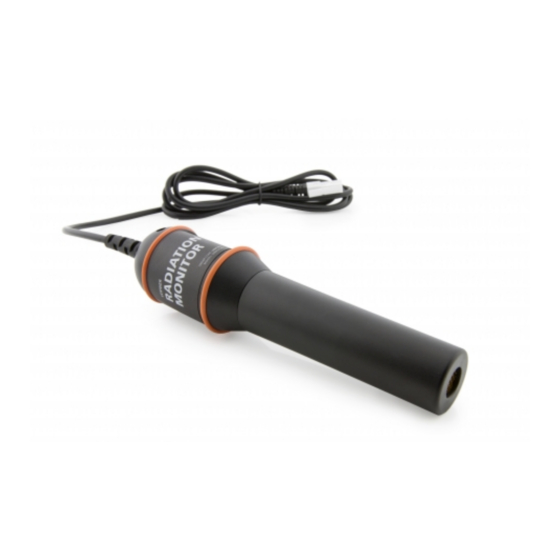
Advertisement
Quick Links
Vernier Radiation
Monitor
(Order Code VRM-BTD)
The Vernier Radiation Monitor is used to monitor
alpha, beta, and gamma radiation. It can be used with a
number of interfaces to measure the total number of counts per specified timing
interval.
Use this sensor to
Detect the presence of a source of radiation.
l
Monitor counts/interval (rate) as different thicknesses of a particular type of
l
shielding are placed between the Geiger-Mueller tube of the Radiation Monitor
and a beta or gamma source.
Compare the effect of different types of materials to shield beta or gamma
l
radiation.
Set up a histogram with a very long run time to show students how initial
l
randomness of data develops first in a Poisson distribution, and then into a
Gaussian distribution curve.
Measure radiation of common radioactive materials, such as lantern mantels or
l
pre-World War II Fiestaware.
Monitor variation in background radiation at different elevations.
l
Monitor radioactivity in the environment over long periods of time.
l
Monitor counts per interval (rate) from a beta or gamma radiation source as a
l
function of the distance between the source and the Radiation Monitor.
Note: Vernier products are designed for educational use. Our products are not
designed nor are they recommended for any industrial, medical, or commercial
process such as life support, patient diagnosis, control of a manufacturing
process, or industrial testing of any kind.
Compatible Software
See
www.vernier.com/manuals/vrm-btd
Radiation Monitor.
Getting Started
1. Connect the sensor to the interface (LabQuest Mini, LabQuest 2, etc.).
2. Start the appropriate data-collection software (Logger Pro, Logger Lite,
LabQuest App, or Graphical Analysis 4) if not already running, and choose
New from File menu. The software will identify the sensor and load a default
data-collection setup. You are now ready to collect data.
If you are collecting data using a Chromebook™, mobile device such as iPad
Android™ tablet, or a Vernier wireless interface, please see the following link for
up-to-date connection information:
www.vernier.com/start/vrm-btd
for a list of software compatible with the
Videos
View videos related to this product at
Specifications
Sensor
Gamma sensitivity
Temperature range
Operating range CPS
Note: This sensor is equipped with circuitry that supports auto-ID. When used
with LabQuest 2, LabQuest, LabQuest Mini, LabPro, SensorDAQ, TI-Nspire™
Lab Cradle, or CBL 2™, the data-collection software identifies the sensor and
uses pre-defined parameters to configure an experiment appropriate to the
recognized sensor.
Suggested Experiments
Counts/Interval vs. Distance Studies
The data in the two graphs below were collected by monitoring gamma radiation
at various distances from a Radiation Monitor. Data were collected with the run
intervals set at 100 seconds. After each 100-second interval, the source was moved
one centimeter further from the source. Since distance is proportional to time (300
seconds in the first graph corresponds to 3 cm in the second graph;
400 seconds to 4 cm, etc.), a new distance column was made using time divided
by 100. The curved fit shown corresponds to distance raised to the –2 power
(inverse squared).
Counts/interval vs. time and distance
Counts/Interval vs. Shielding Studies
The data shown here were collected by monitoring gamma radiation with an
®
increasing number of pieces of silver foil placed between the source and a
or
Radiation Monitor. Data was collected with the run interval set at 100 seconds.
After each 100-second interval, another piece of silver foil was placed between the
source and the Radiation Monitor. Since the number of pieces is proportional to
1
http://www.vernier.com/vrm-btd
LND 712 (or equivalent) halogen-quenched GM tube
with a 1.5 to
2
2.0 mg/cm
mica end window
18 cps/mR/hr referenced to Co-60
–20 to 50°C
0–3,500
Advertisement

Summary of Contents for Vernier VRM-BTD
- Page 1 If you are collecting data using a Chromebook™, mobile device such as iPad Radiation Monitor. Data was collected with the run interval set at 100 seconds. Android™ tablet, or a Vernier wireless interface, please see the following link for After each 100-second interval, another piece of silver foil was placed between the up-to-date connection information: source and the Radiation Monitor.
- Page 2 time (300 seconds corresponds to 3 pieces of foil, 400 seconds to 4 pieces of foil, Histogram Data Analysis For an easy in-class experiment, set up a histogram with a very long run time and etc.), a new column, pieces of silver foil, was made using time divided by 100. start data collection.
- Page 3 It allows alpha particles to reach the GM This book has six experiments written for the Vernier Radiation Monitor. Each of tube and be detected. The mica window will also sense low energy beta particles the six experiments has a computer version (for LabPro, LabQuest, or LabQuest and gamma radiation that cannot penetrate the plastic case or the side of the tube.
- Page 4 Tubes that fail within a year of Logger Pro, Logger Lite, Graphical Analysis, Vernier LabQuest, Vernier LabQuest Mini, and other marks shown are our trademarks or registered trademarks in the United States.
















Need help?
Do you have a question about the VRM-BTD and is the answer not in the manual?
Questions and answers